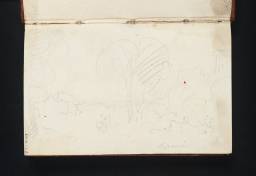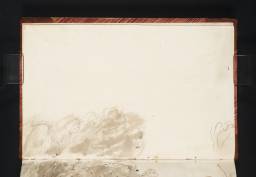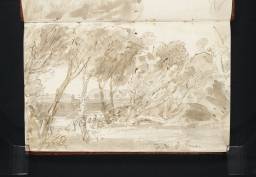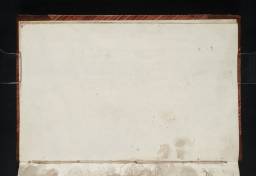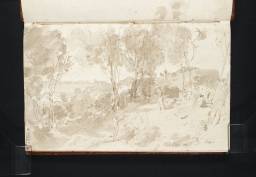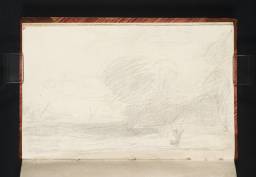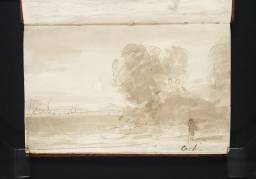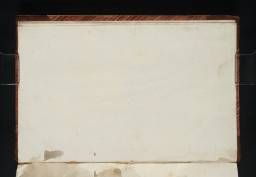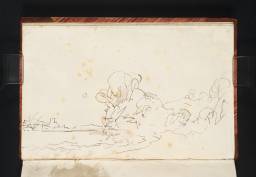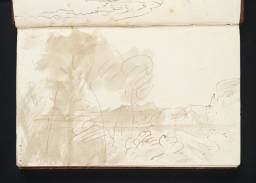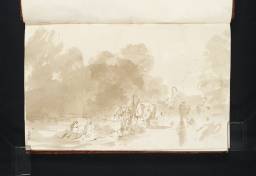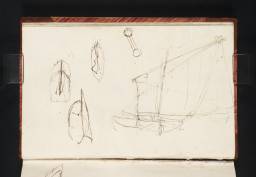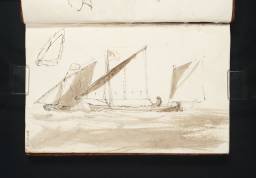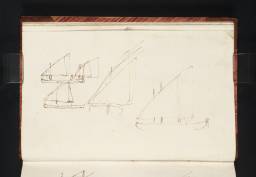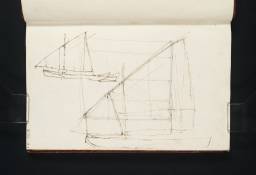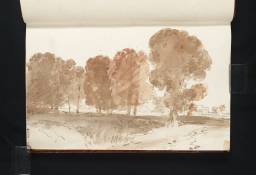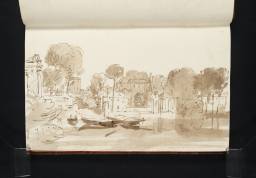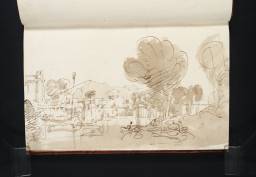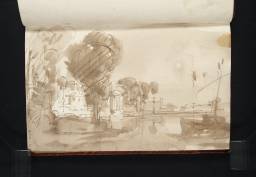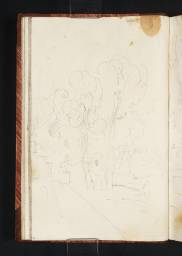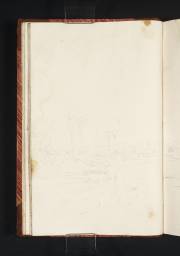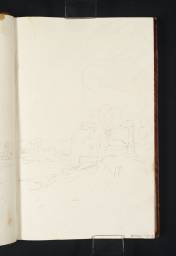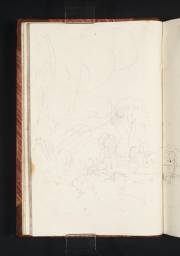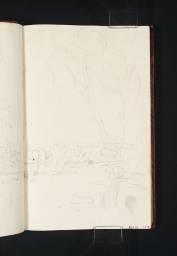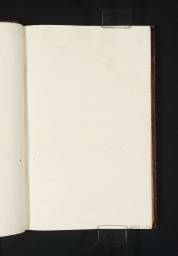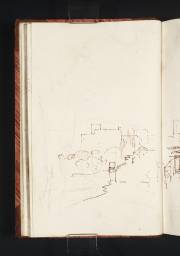J.M.W. Turner
>
1802-18 Academician and professor
>
Thames sketchbooks c.1804-14
>
Wey, Guildford Sketchbook
Turner Bequest XCVIII
Sketchbook, quarter-bound, with calf spine and corners and red comb-striped paper boards
138 leaves of white laid paper made on a single-faced mould
Approximate page size 117 x 182 mm
Made by an unidentified maker (but see Technical Notes below), and watermarked with an ornamental fleur-de-lys and countermarked with the monogram ‘HH’ and symbol ‘4’
Inscribed by Turner in ink ‘74 Wey Guilford’ on a label on the spine
Endorsed by the Executors of the Turner bequest ‘No 165’ and signed in ink by Henry Scott Trimmer and Charles Turner ‘H.S. Trimmer’ and C Turner’ and in pencil by Charles Lock Eastlake and John Prescott Knight ‘C.L.E.’ and JPK’ inside front cover
Stamped in black ‘XCVIII’ inside front cover
138 leaves of white laid paper made on a single-faced mould
Approximate page size 117 x 182 mm
Made by an unidentified maker (but see Technical Notes below), and watermarked with an ornamental fleur-de-lys and countermarked with the monogram ‘HH’ and symbol ‘4’
Inscribed by Turner in ink ‘74 Wey Guilford’ on a label on the spine
Endorsed by the Executors of the Turner bequest ‘No 165’ and signed in ink by Henry Scott Trimmer and Charles Turner ‘H.S. Trimmer’ and C Turner’ and in pencil by Charles Lock Eastlake and John Prescott Knight ‘C.L.E.’ and JPK’ inside front cover
Stamped in black ‘XCVIII’ inside front cover
Accepted by the nation as part of the Turner Bequest 1856
Exhibition history
1987
Watercolours from the Turner Bequest, Tate Gallery, London, April–October 1987 (no number).
1990
Painting and Poetry: Turner’s ‘Verse Book’ and his Work of 1804–1812, Tate Gallery, London, June–September 1990 (28).
2002
Turner et le Lorrain, exhibition catalogue, Musée des beaux-arts, Nancy, December 2002–March 2003 (11).
References
1909
A.J. Finberg, A Complete Inventory of the Drawings of the Turner Bequest, London 1909, vol.I, pp.253–5, XCVIII.
1961
A.J. Finberg, A Life of J.M.W. Turner, R.A., Second Edition, Revised, with a Supplement by Hilda F. Finberg, Oxford 1961, p.137.
1969
John Gage, Colour in Turner: Poetry and Truth, London 1969, pp.36–8.
1974
Gerald Wilkinson, The Sketches of Turner, R.A. 1802–20: Genius of the Romantic, London 1974, pp.83–6.
1977
Gerald Wilkinson, Turner Sketches 1789–1820, London 1977, pp.120–2.
1982
Evelyn Joll and Martin Butlin, L’opera completa di Turner 1793–1829, Milan 1982, pp.85–8.
1984
Martin Butlin and Evelyn Joll, The Paintings of J.M.W. Turner, revised ed., New Haven and London 1984, p.120–3.
1990
Gerald Finley, ‘Love and Duty: J.M.W. Turner and the Aeneas Legend’, Zeitschrift für Kunstgeschichte, vol.55, no.3, 1990, p.370.
1990
Kathleen Nicholson, Turner’s Classical Landscapes: Myth and Meaning, Princeton 1990, pp.264, 268–9, 272, 276–7.
1990
Andrew Wilton and Rosalind Mallord Turner, Painting and Poetry: Turner’s ‘Verse Book’ and his Work of 1804–1812, exhibition catalogue, Tate Gallery, London 1990, p.125.
1991
David Blayney Brown, Oil Sketches from Nature: Turner and his Contemporaries, exhibition catalogue, Tate Gallery, London 1991, p.48.
1993
David Hill, Turner on the Thames: River Journeys in the Year 1805, New Haven and London 1993, pp.25, 63–4, 71, 75–82, 122, 132–6, 159–61, 163–5, 167–9.
2001
David Hill, ‘Thames Sketches, 1805’, in Evelyn Joll, Martin Butlin and Luke Herrmann eds., The Oxford Companion to J.M.W. Turner, Oxford 2001, pp.333–5.
Jan Piggott, ‘Virgil’, in Oxford Companion, pp.365–6.
2002
Ian Warrell, Blandine Chavanne and Michael Kitson, Turner et le Lorrain, exhibition catalogue, Musée des beaux-arts, Nancy 2002, p.60 reproduced in colour.
This sketchbook belongs to the group used on or near the Thames, mainly from circa 1805. In use during Turner’s period of residence at Sion (or Syon) Ferry House, Isleworth during the summer of 1805 and containing views of scenery nearby, it also records a tour of the Wey and Godalming Navigations. In addition, and typically of Turner’s Isleworth sketchbooks, there are studies of classical or historic landscapes with subjects from Virgil’s Aeneid and Homer’s Iliad and Odyssey. A number of important pictures and an exhibition watercolour originate in this book.
In his Inventory Finberg dated the sketchbook ‘about 1807’ and then in the Life reiterated his belief that this was its ‘most probable date’. The main evidence for the earlier dating of 1805 is the study across folios 133–132 verso (D06351–D06350) which Turner used as the basis for Windsor Castle from the Thames (Tate T03870; displayed at Petworth House).1 The picture is inscribed ‘ISLEWORTH’ along with the signature, indicating that it was painted at Sion Ferry House, is datable on stylistic grounds circa 1805 and might have been exhibited at Turner’s Gallery that year or the next. The coloured study for the same picture in the Studies for Pictures: Isleworth sketchbook (Tate D05532: Turner Bequest XC 29a) indicates that Turner used the two sketchbooks concurrently, and there are further connections between the views of Isleworth and Richmond scenery in both of them and in the Hesperides (1) sketchbook (Tate D05766–D05842; D05844; D40632; D40634–D40636; Turner Bequest XCIII) also in use at Sion Ferry House. Views of Windsor, Godalming and Guildford dovetail with oil sketches made at the same time. The close relationship between drawn and painted sketches contradicts John Gage’s division of the oils, proposed in his 1969 book, into three groups, only one of which (containing what he termed the most ‘primitive’) he associated with the sketchbook and dated 1809–10.2 Dating the book to the same period, Gage mistakenly stated that it ‘contains studies for pictures and engraved work, the earliest of which was exhibited or published in 1811’.3
As noted by David Hill, whose 1993 book was the first significant advance on Finberg, Turner seems to have started sequences of drawings working from both ends of the sketchbook. Views of Windsor and Eton running from near the back were used for two pictures. Folio 136 verso (D06358) has a drawing of Eton College Chapel that served as the basis for The Thames at Eton (Tate T03873; displayed at Petworth House)4 exhibited at Turner’s Gallery in 1808 and folios 134–133 verso (D06353–D06352) a view of Windsor Castle which was freely adapted for Near the Thames Lock, Windsor (Tate T03877; displayed at Petworth House)5 shown there in 1809. Turner was perhaps already planning these pictures, which were bought by the Earl of Egremont, for the Windsor drawings and oil sketches indicate a campaign of collecting views of the Castle and its surroundings. Turner was doubtless familiar with the many views of Windsor made by Thomas Sandby, the Royal Academy’s first Professor of Architecture, and his brother Paul and his view of the North Terrace (folios 125–124 verso; D06335–D06334) reprises a favourite subject of Paul’s.6 Views of Windsor Castle from folio 135 verso (D06356) to 124 verso (if made from the back of the book) include a panorama from the Terrace looking east and west and running across several pages. This seems especially to recall the Sandbys and perhaps also Thomas’s use of the camera obscura to draw his perspectives.7 Turner’s oil sketches of Windsor, painted on wood panels, also adopt a panoramic format (Tate N02306, N02308, N02312, N02678, N02691).8
Following on from the Windsor drawings, assuming Turner was still working backwards through the book, are those recording his tour of the Wey and Godalming Navigations. Connecting Godalming and Guildford to the Thames at Weybridge, the River Wey had been opened up to commercial barge traffic by canalisation and a system of locks. Presumably Turner used his own boat for the tour. Diagrams of boats on folios 7 verso–9 (D06190–D06193) might be related to this vessel were it not for the fact that they show a low freeboard and lateen rig more suitable for the Mediterranean than the Thames. The table of accounts written inside the back cover of the book lists his expenses during the trip, from Hampton through Ripley, Guildford and Godalming where larger spending indicates overnight stays, as observed by Hill.9 Amusingly, Finberg stated in his Life that Turner’s ‘1st Catch’ cost him three shillings and sixpence, noting that ‘on this occasion he combined the labour of angling with his diversions of painting and sketching’.10 While we may be sure that Turner did plenty of fishing, Finberg had misread his writing, which actually refers to St Catherine’s – the lock and ferry near Guildford. As with the Windsor subjects in the book, drawings of Godalming, St Catherine’s Hill, Guildford and Newark Priory made on the Wey tour overlap with oil sketches, doubtless made at the same time (Tate N02304, N02676, N02310, N02302, N02677).11
Composition studies of historic landscape, reminiscent of Claude Lorrain, occupy the first part of the book, from folio 1 (D06180) to 7 (D06189). 1 and 1 verso–2 (D06181–D06182) illustrate Virgil’s Aeneid and show Aeneas’s son Ascanius shooting Silvia’s stag, and Dido and Aeneas, respectively. These, particularly the second, relate to similar designs in the Studies for Pictures: Isleworth sketchbook. From Homer’s Odyssey Turner has drawn two subjects, Ulysses and Nausicaa on folios 2 verso–3 (D40594–D06183) and Ulysses and Polyphemus on folios 4 verso–5 (D41507–D06186), the first of which also links up with a drawing in the Studies sketchbook. Turner associated the stories of Dido and Aeneas and Ulysses and Nausicaa, drawing them in a complementary style, and moreover, as Kathleen Nicholson has noted, he may have been aware that Virgil’s account of the former couple was based on Homer’s of the latter. Nicholson also observes that the subject of Ulysses’s taunting of Polyphemus complements the Nausicaa episode by showing contrasting aspects of his heroic character; defiance in the first instance and humility in the second.
The drawing of Ulysses and Polyphemus is probably the earliest idea for what eventually became Ulysses Deriding Polyphemus – Homer’s Odyssey (National Gallery, London),12 exhibited in 1829, Turner’s only Homeric subject in oil. Whether he was planning such a picture at this early stage is debatable and the classical subjects in this sketchbook might be better associated with his developing ideas for the Liber Studiorum. However, paint splashes on the drawing indicate that he did refer to it while painting the picture. Folios 3 verso, 5 and 5 verso (D01684, D01685, D01687) have drawings related to the watercolour Chryses (private collection),13 shown at the Royal Academy in 1811. Turner’s first exhibited representation of Homer, this illustrates the Iliad and was accompanied by a quotation from Alexander Pope’s translation of it. Turner is likely to have seen these two Homeric subjects as complementary. Ulysses Deriding Polyphemus was given arched rocks similar to those in Chryses and already present in the drawings, and as Andrew Wilton has observed, the manifestations of the elements of earth, air and water in the 1829 painting and of sunlight in the 1811 watercolour (where it represents the sun-god Apollo) link these works conceptually. The Chryses drawings were probably developed from others in the Studies for Pictures: Isleworth sketchbook (Tate D05541, D05588, D05597; Turner Bequest XC 34, 61a, 69).
Particularly interesting among the classicising drawings is a group of four in which views across the river at Isleworth towards Sion Ferry House and Robert Mylne’s Pavilion at the corner of Syon Park become progressively idealised and antique, with mountains or triremes (folios 11–14, D06195–D06198). These echo the classical transcriptions of Thames scenery in Studies for Pictures: Isleworth especially and might anticipate the Isleworth plate in the Liber Studiorum (see Tate D08163; Turner Bequest CXVIII I). Turner’s handling of pen and monochrome wash in these and other studies in this book suggests knowledge of original drawings by Claude or of Richard Earlom’s Liber Veritatis – engraved plates after the master’s drawings published in 1777.
A.P. Oppé, The Drawings of Paul and Thomas Sandby in the Collection of His Majesty the King at Windsor Castle, Oxford and London 1947, pp.19–22; Jane Roberts, Views of Windsor: Watercolours by Thomas and Paul Sandby from the Collection of Her Majesty Queen Elizabeth II, London 1995, pp.64–7; Matthew Craske, ‘Court Art Reviewed: the Sandbys’ Vision of Windsor and its Environs’, in John Bonehill and Stephen Daniels eds., Paul Sandby: Picturing Britain, exhibition catalogue, Nottingham Castle Museum and Art Gallery, Nottingham 2009, pp.49–55.
Butlin and Joll 1984, p.121 nos.180 (pl.180), 179 (pl.179), 177 (pl.177), 178 (pl.178); p.117 no.163 (pl.163).
Technical Notes
Peter Bower14 states that the format of this book is Demy or Medium Octavo and that it is made up of writing paper. Bower observes that the watermark design and the details of its construction are English while the countermark is more typical of continental papermakers; and that the ‘4’ symbol dates from the fifteenth century and is anachronistic for the early nineteenth, having largely fallen out of use in English marks by the 1770s. Bower has found no English papermakers active around ‘1807’, but cites Henry Hughes, working Hayfield (or Heafield) Mill, Derbyshire in 181415 and Henry Harris, working Langley Mill, Milsom, Shropshire in 1816.16
Bower further observes that the drawings in pen and ink are predominantly made on the wireside of the leaves. The likelihood that Turner worked from each end of the book has been mentioned above. He left many leaves in the middle of the book unused.
Hill suggests that folio 137 (D06359) and 138 (D06361) were added to the back of the book, noting that 137 lacks water stains present elsewhere. On the basis that 138 leaves is ‘a strange number’ and that the book was more probably originally composed of 144 (or eighteen signatures of eight leaves), he proposes that four may now be missing. He further speculates that the covers have been reversed. This cannot be confirmed.17
David Blayney Brown
July 2009
-
Joseph Mallord William TurnerWey, Guildford SketchbookD06180
-
Joseph Mallord William TurnerWey, Guildford SketchbookD06181
-
Joseph Mallord William TurnerWey, Guildford SketchbookD06182
-
-
-
-
-
Joseph Mallord William TurnerWey, Guildford SketchbookD41507
-
-
-
Joseph Mallord William TurnerWey, Guildford SketchbookD06188
-
Joseph Mallord William TurnerWey, Guildford SketchbookD06189
-
Joseph Mallord William TurnerWey, Guildford SketchbookD06190
-
Joseph Mallord William TurnerWey, Guildford SketchbookD06191
-
Joseph Mallord William TurnerWey, Guildford SketchbookD06192
-
Joseph Mallord William TurnerWey, Guildford SketchbookD06193
-
Joseph Mallord William TurnerWey, Guildford SketchbookD06194
-
Joseph Mallord William TurnerWey, Guildford SketchbookD06195
-
Joseph Mallord William TurnerWey, Guildford SketchbookD06196
-
Joseph Mallord William TurnerWey, Guildford SketchbookD06197
-
Joseph Mallord William TurnerWey, Guildford SketchbookD06198
-
-
Joseph Mallord William TurnerWey, Guildford SketchbookD06200
-
Joseph Mallord William TurnerWey, Guildford SketchbookD06201
-
Joseph Mallord William TurnerWey, Guildford SketchbookD06202
-
Joseph Mallord William TurnerWey, Guildford SketchbookD06203
-
Joseph Mallord William TurnerWey, Guildford SketchbookD06204
-
Joseph Mallord William TurnerWey, Guildford SketchbookD06205
-
-
Joseph Mallord William TurnerWey, Guildford SketchbookD06207
How to cite
David Blayney Brown, ‘Wey, Guildford sketchbook 1805’, sketchbook, July 2009, in David Blayney Brown (ed.), J.M.W. Turner: Sketchbooks, Drawings and Watercolours, Tate Research Publication, December 2012, https://www

